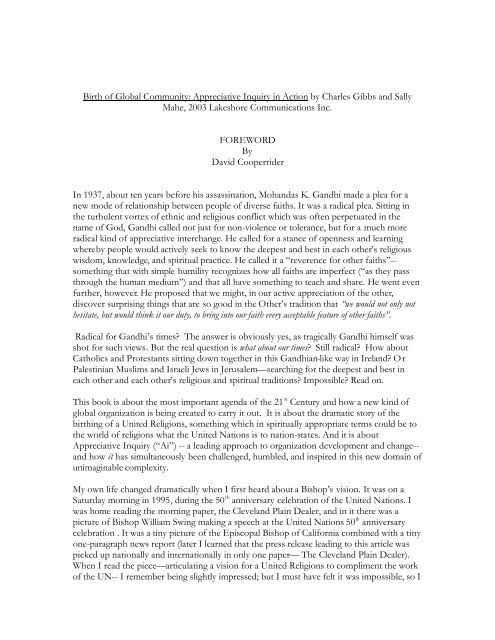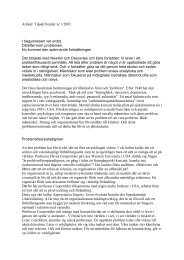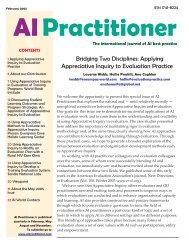Birth of Global Community - The Appreciative Inquiry Commons
Birth of Global Community - The Appreciative Inquiry Commons
Birth of Global Community - The Appreciative Inquiry Commons
- No tags were found...
Create successful ePaper yourself
Turn your PDF publications into a flip-book with our unique Google optimized e-Paper software.
<strong>Birth</strong> <strong>of</strong> <strong>Global</strong> <strong>Community</strong>: <strong>Appreciative</strong> <strong>Inquiry</strong> in Action by Charles Gibbs and SallyMahe, 2003 Lakeshore Communications Inc.FOREWORDByDavid CooperriderIn 1937, about ten years before his assassination, Mohandas K. Gandhi made a plea for anew mode <strong>of</strong> relationship between people <strong>of</strong> diverse faiths. It was a radical plea. Sitting inthe turbulent vortex <strong>of</strong> ethnic and religious conflict which was <strong>of</strong>ten perpetuated in thename <strong>of</strong> God, Gandhi called not just for non-violence or tolerance, but for a much moreradical kind <strong>of</strong> appreciative interchange. He called for a stance <strong>of</strong> openness and learningwhereby people would actively seek to know the deepest and best in each other’s religiouswisdom, knowledge, and spiritual practice. He called it a “reverence for other faiths”--something that with simple humility recognizes how all faiths are imperfect (“as they passthrough the human medium”) and that all have something to teach and share. He went evenfurther, however. He proposed that we might, in our active appreciation <strong>of</strong> the other,discover surprising things that are so good in the Other’s tradition that “we would not only nothesitate, but would think it our duty, to bring into our faith every acceptable feature <strong>of</strong> other faiths”.Radical for Gandhi’s times? <strong>The</strong> answer is obviously yes, as tragically Gandhi himself wasshot for such views. But the real question is what about our times? Still radical? How aboutCatholics and Protestants sitting down together in this Gandhian-like way in Ireland? OrPalestinian Muslims and Israeli Jews in Jerusalem—searching for the deepest and best ineach other and each other’s religious and spiritual traditions? Impossible? Read on.This book is about the most important agenda <strong>of</strong> the 21 st Century and how a new kind <strong>of</strong>global organization is being created to carry it out. It is about the dramatic story <strong>of</strong> thebirthing <strong>of</strong> a United Religions, something which in spiritually appropriate terms could be tothe world <strong>of</strong> religions what the United Nations is to nation-states. And it is about<strong>Appreciative</strong> <strong>Inquiry</strong> (“Ai”) -- a leading approach to organization development and change--and how it has simultaneously been challenged, humbled, and inspired in this new domain <strong>of</strong>unimaginable complexity.My own life changed dramatically when I first heard about a Bishop’s vision. It was on aSaturday morning in 1995, during the 50 th anniversary celebration <strong>of</strong> the United Nations. Iwas home reading the morning paper, the Cleveland Plain Dealer, and in it there was apicture <strong>of</strong> Bishop William Swing making a speech at the United Nations 50 th anniversarycelebration . It was a tiny picture <strong>of</strong> the Episcopal Bishop <strong>of</strong> California combined with a tinyone-paragraph news report (later I learned that the press release leading to this article waspicked up nationally and internationally in only one paper— <strong>The</strong> Cleveland Plain Dealer).When I read the piece—articulating a vision for a United Religions to compliment the work<strong>of</strong> the UN-- I remember being slightly impressed; but I must have felt it was impossible, so I
tossed the paper in the recycling bin. Not another thought. But later in the afternoon Ishared what I had read with Nancy, my wife. She said she wanted to read it too. So Irecovered it from the recycle bin in the garage and we read the article together. This time myheart started pounding, for one thing because my research interests at the WeatherheadSchool <strong>of</strong> Management at Case Western Reserve University had recently turned to studies <strong>of</strong>“new forms <strong>of</strong> human cooperation and global action”.While most <strong>of</strong> my work was in the business world I started to think about the implications<strong>of</strong> a United Religions. Its purpose would not be to create one unified world religion (just likethe UN is not to take away from the sovereignty <strong>of</strong> nations) but a place to work out ourglobal interdependencies. <strong>The</strong> logic was compelling. Indeed reports show that over half theworld’s armed conflicts are not between nation states at all but between groups <strong>of</strong> differingethnic and religious identities. What are our world’s religious leaders doing, not alone buttogether, about these conflicts?Why too, I asked myself—after we have seen CNN pictures <strong>of</strong> black and white comingtogether like Mandela and DeKlerk spontaneously holding up each other’s hands in thesoccer stadium—why no similar pictures <strong>of</strong> our religious leaders, for example the Pope andDalai Lama, doing the same? Do many <strong>of</strong> us believe—did I believe—that religions togethercould be more <strong>of</strong> a worldwide force for peace and cooperation than bitterness andseparation? I turned to Nancy and said: “if something like a UN among people <strong>of</strong> theworld’s religions could be created, it might well help change human relationships more thanany other kind <strong>of</strong> organization I know”.As a scholar and researcher I wanted to study it. I wanted to see the whole thing evolve fromthe beginning moments <strong>of</strong> creation. I wrote a long letter to the Bishop that night and I senthim a chapter from a new book I was writing with Jane Dutton at University <strong>of</strong> Michigan on<strong>The</strong> Organization Dimensions <strong>of</strong> <strong>Global</strong> Change: No Limits to Cooperation. But I was openabout it:: “we are infants in our understandings about how to create organizations <strong>of</strong> thekind you are speaking about so it would be an amazing privilege to be able to observe, todocument, and to learn”. Three days later I received a call from the Bishop’s key colleague inthe initiative, the Rev. Charles Gibbs. He came to visit us right away at Case WesternReserve University and shortly after that an advanced doctoral student in OrganizationalBehavior Gurudev Khalsa, and I, visited the initiative’s whole team in San Francisco. BishopSwing had just returned from a trip around the world. His report was split right down themiddle. About half the world’s religious leaders thought the idea was totally utopian. <strong>The</strong>other half said it was absolutely needed. Almost all said they would pray for it.Within thirty minutes the Bishop challenged us when he said: “we do not need you to stay inthe ivory tower and study the effort at arms length. We invite you right here to join us, tobring your organization development backgrounds and the spirit <strong>of</strong> the appreciative inquiryto our first summit”. Gurudev and I signed on. We agreed, without any need to discuss it, topartner. And we said yes about bringing the AI Summit approach—a whole systems,strength-based, large group planning methodology—to help launch a five year process forcreating a vision, charter, and plan for a United Religions.Two minutes after that meeting we jumped right into another, with Sally Mahe and CharlesGibbs, the authors <strong>of</strong> this amazing book. <strong>The</strong>y introduced us to the host committee for the
first global summit for creating a charter for a United Religions. <strong>The</strong> summit dates werealready set. And the summit, which was to be held in the room where the UN Charter wasdrafted at the Fairmount Hotel in San Francisco, was less than two months away. We starteddesigning and preparing for it that day. It was thrilling.This book tells the organization development story <strong>of</strong> the next five years: the global AISummits held at Stanford University, the Fairmount Hotel in San Francisco, and Pittsburgh;the charter writing meetings taking in places all over the world like Caracas, Oxford, BuenosAires, Nairobi, New York City and others; the dozens <strong>of</strong> organizational design meetings withbrilliant business leaders like Visa’s Dee Hock; and <strong>of</strong> course, the exciting moments <strong>of</strong>birthing the URI at the charter signing celebration at Carnegie Music Hall in June <strong>of</strong> 2000.Right now, as I write these words, there are over 200 United Religions centers or“cooperation circles” on every continent bringing together Hindus, Muslims, Christians,Buddhists, Jews, Zoroastrians, Jains, Indigenous spiritual traditions, Bahai and many more.<strong>The</strong> mission is strong: <strong>The</strong> purpose <strong>of</strong> the United Religions Initiative(URI) is to promote enduring,daily interfaith cooperation, end religiously motivated violence and create cultures <strong>of</strong> peace, justice and healingfor the Earth and all living beings.I believe the URI is an organization that could, like the International Physicians for NuclearWar, be one <strong>of</strong> the very few organizations that are nominated for and receive a Nobel PeacePrize. <strong>The</strong> work <strong>of</strong> the URI is that important. It could happen in our lifetime.Remarkable in its depth is a view <strong>of</strong> the promises and potentials appreciative inquiry,organizational design, large-group summit methods, and spiritual practices for bringingpeople together across boundaries <strong>of</strong> all kinds. This book is a unique resource for peopleinvolved in organization development and change leadership. To be sure, this volume is apractical guide with tools and insights. But it is not your typical guide. It is not superficial. Itis not just about forms and worksheets. It is a narrative guide, probably the very best kind, <strong>of</strong>teaching while telling a story. It shows the reader a “way” without prescribing a narrow ormisleading “six sure fire steps”. Work in the real world is emergent and dazzling. And thisbook is about the real thing. Through storytelling like Margaret Mead might do, one learns atlevels that are tremendously beneficial. This book should be in the library <strong>of</strong> every personinterested in organizational design, interfaith and international relations, social movementorganizing, and appreciative inquiry.My many feelings <strong>of</strong> gratitude are <strong>of</strong>fered to Charles Gibbs and Sally Mahe and all thepeople <strong>of</strong> URI who have helped to lift up a new hope in the world. In this seminal workCharles and Sally have provided each one <strong>of</strong> us a gift. It is a gift <strong>of</strong> passion and compassion,<strong>of</strong> courage and humility, and <strong>of</strong> literary inspiration. Most <strong>of</strong> all it is a precious example,much like the Dalai Lama’s <strong>The</strong> Good Heart, <strong>of</strong> the power <strong>of</strong> appreciative ways <strong>of</strong> knowing,valuing, and learning from the Other.David L. CooperriderWeatherhead School <strong>of</strong> ManagementCase Western Reserve UniversityJanuary, 2003






